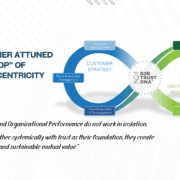5 Ways to Maximise Your Investment in Developing a Capability Framework
Does your business have a capability framework in place for your people that clearly lays out the knowledge, skills and expertise needed to work effectively in each role? If the answer is yes, the secondary question is: are you getting maximum value from the investment you put in to create it in the first place? If on the other hand, you don’t have such a framework, you might be wondering if it is worth the effort – it’s not after all immediately going to boost sales or magnify pipeline activity – so where is the return?
In this article, we take a look at five ways in which you can get real value out of a capability framework so you achieve a significant return on your investment and tangible benefits for many parts of the business.
What do we mean by a capability framework?
First and foremost a heartfelt view formed from our experience: a capability framework does not have to be a large behemoth that takes years to develop. It does need to be pragmatic and appropriate for the size, complexity and maturity of your business.
At a simple level, the first stage is to consider the core capability areas required to be successful in a particular function. For example, for your Business Development function, you may wish to have capabilities in
- Sales
- Relationship management
- Market & business knowledge
- Effective communications, etc.
Each of these core capabilities can then be broken down further into specific competency requirements. So, for sales, you may wish to include competencies such as:
- Prospecting
- Sales scoping & qualification
- Sales proposals & presentations
- Sales closing & agreements, etc.
The next stage is to consider how many levels of differentiation you would expect to see in your business. We would suggest that at a minimum there should be three levels of differentiation from beginner, through to intermediate and then expert. But we have seen and worked on frameworks with four, five and even seven levels of differentiation applied. Do bear in mind that the more levels of differentiation, the more complex the model and the more work involved, but it can give a greater level of granularity.
The final stage of building the framework, and in our experience the most time-consuming part, is developing and agreeing the descriptors (in one to three succinct sentences) that need to be added into each ‘cell’ of the framework. Using the example above, how would you describe the skills and experience you would expect to see for sales scoping and qualification at a beginner level, at an intermediate level and at an expert level? And of course, if you have too many different levels, it gets ever more challenging to differentiate what you would expect to see at each level.
Once you have your populated your framework, the next step is to make use of the framework to capture some initial data by conducting an assessment of current capability across the business. How to conduct this analysis needs to reflect the maturity of your business, the business complexity, the level of detail required from any analysis, the resource available to conduct the analysis, and so on. A simple online self-assessment question set combined with a manager review can provide a very good indication of skill levels across a business – and that is easy to administer and not a burden on the business. Remember, keep it simple and don’t forget the end goal of using it to drive actions to deliver your business strategy.
Now you have invested the time in developing a capability framework for your business and you have done some initial data collection – how can you get the best value from it?
So crucially, here are 5 ways to maximise your framework:
- Inform your business strategy
Review your business strategy – have you got the correct number of people with the right skills to deliver your current business plan? At an operational level, the results of your analysis can help inform your workforce management and planning. Looking forward, if you are seeking to broaden your footprint into new segments, lines of business or markets, have you got the appropriate resource to support these goals? If not, can you develop from within or do you need to recruit?
- Enable targeted training and development activity
Many businesses will have a gut feeling for where their gaps are in capability and will invest in recruiting or developing their teams accordingly. But if this is the only route taken, this can lead to a scattergun approach to development activity and a lack of focus on developing the capabilities that are most required to support strategy. Instead, use the framework analysis to identify your key skill gaps for your business strategy and then target your development resource and budget to addressing these priorities. Otherwise, it is all too easy to commit to training solutions only for the part of the business that shouts loudest!
- Improve your recruitment process
Aligning your recruitment processes to your capability framework should make all aspects of recruitment more targeted and cost-effective. Examples are: job adverts that fully reflect the capabilities required for your roles, more focused advertising of roles, better initial screening of applicants so only the most suitable reach the face to face stage, interview questions and assessment exercises aligned to key capabilities so applicants can be objectively tested against priority criteria, and more fundamentally do you recruit to fill capability gaps directly and immediately, or do you recruit people with the potential to be developed to fill future gaps?
- Support your succession plans
Consistency of understanding of core capabilities across different teams, functions and divisions enables you to identify people from all areas of the business with the capabilities needed to fill succession gaps in other parts of the business other than their own. Once you have identified those with the potential to fill roles in the future, you can help them develop any gaps in their capability by giving them a variety of development opportunities to prepare them for the future.
- Drive individual career planning
For any individual in the business, the framework can be used to understand clearly what capabilities are required for different roles and to plan their personal development accordingly. It is an invaluable tool in development discussions between individuals and their leaders and ensures a real consistency across the business, a focus on the end goal and a requirement to plan their specific development activity. It will also provide a demonstration of your commitment to developing your staff – this is a real positive for staff engagement.
So we hope the question you are asking now is: why haven’t we got a capability framework in place?
At Customer Attuned we have considerable experience in the design, development and refinement of capability frameworks and also in helping organisations to get maximum value from their frameworks. If you would like to discuss any of the subjects covered in this article then please do get in touch.







